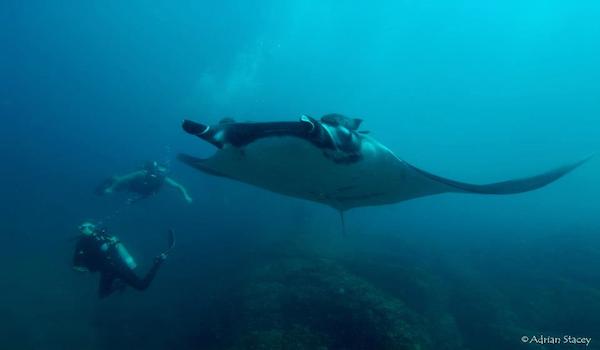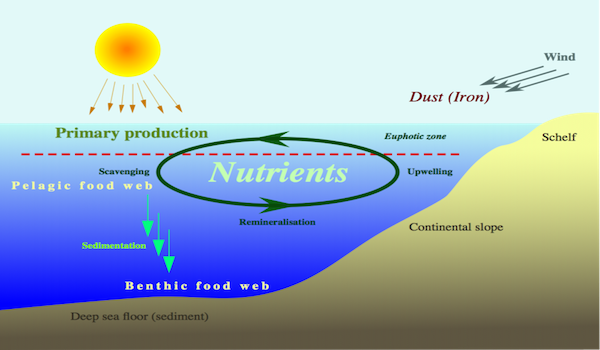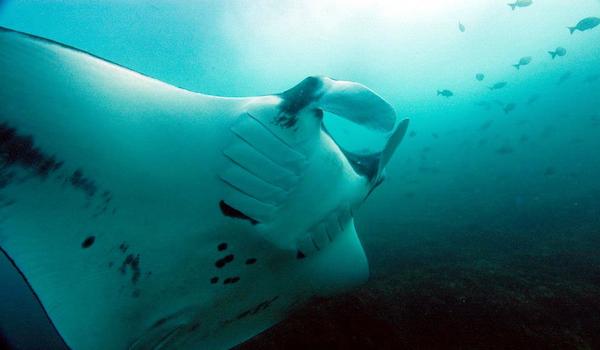When is the Best Time to Dive with Manta Rays in Costa Rica?
Scuba diving with Manta rays in Costa Rica is just one of many reasons to visit this beautiful country. In this article we zoom in on what the best time is to dive with Manta rays in Costa Rica and where to find them,
There are a variety of different species of rays that inhabit the oceans and seas around the globe, and scuba divers of all experience levels often seek out specific dive sites that will allow them to witness the beauty and grace of these creatures in their natural habitats.
But the manta ray, in particular, draws the attention of all underwater adventure seekers because it’s the largest of all the ray species on the planet, growing as large as 7 meters, or about 23 feet, in width.

Manta ray at Catalina Island Costa Rica.
Photo Credit: Rich Coast Diving
Manta Rays love Costa Rica!
In addition to being completely docile and safe to be around, as the species didn’t evolve with a dangerous stinger, these rays are also acrobatic within the water, making them a sight to behold.
One of the best places to encounter manta rays in the wild during a diving expedition is Costa Rica, but knowing where to go and when to see them will dramatically increase your odds of having the experience of a lifetime.
The waters off Costa Rica are rich in marine life, so it’s really no surprise that divers from all over the world flock to these sites in order to experience myriad species up-close and personal like never before. And because the waters off the Pacific Coast of Costa Rica are nutrient, manta rays and other pelagic species just love to spend their time there.

Why Manta rays love Costa Rica? Free food for all :). Photo credit: Wikipedia.
The Best Places to Dive with Manta Rays in Costa Rica?
Manta rays can be found at various dive sites throughout Costa Rica, so going on an excursion with a reliable dive centre will help you target the best sites where the encounter is most likely to happen.
However, before you set off on your journey to Costa Rica and its many dive sites, remember that the best places to see manta rays in all their glory include the Bat Islands AKA Islas Murcielago, Catalina Islands AKA The Cats. Both sites can be reached by boat from the Guanacaste Coast of this beautiful country. Other great sites for spotting many massive manta rays include Nicoya Peninsula, Tortuga Island, Cabo Blanco Nature Reserve Park, Coco Island, and Osa Peninsula.
The Best Time of Year to Dive with Manta Rays in Costa Rica
To experience the truly massive manta rays of the Catalina Islands in Costa Rica, the best time of year to visit would be between the months of November and May.
Some of these manta rays weigh around 1,363 kg, or 3,000 lbs, and with their incredible wingspans that can reach as wide as 7.3 meters, or 24 feet, they’re amazing creatures that you’ll never forget.
Plus, because they’re slow moving creatures, you can bring your underwater camera to take plenty of gorgeous photographs as these awesome marine animals glide past you with grace and ease.

Scuba dive with Manta Rays in Costa Rica
Photo credit: Rich Coast Diving
Keep in mind that the manta ray season for this area also brings in colder water temperatures. Be prepared for your trip beneath the waves by donning a 3MM or 5MM wetsuit, depending upon how well you can typically tolerate colder temperatures. But even if you’re going to be a bit chilly, it will be worth it to see the schools of manta rays that these colder temperatures bring.
Experience Level Required to dive with manta rays in Costa Rica?
Because manta rays are docile but often aggregate in deeper water of the Catalina Islands divers should have at least be certified as an Advanced diver.
Have you ever had an encounter with a Manta Rays in Costa Rica or anywhere else? Let us know in the comments below
Feel free to contact us. We have multiple partners in Costa Rica who offer dive packages + accommodation so you can experience the magic of the Manta Rays in Costa Rica.
This article is published by The Scuba Page, the online magazine for Scuba Dive lovers around the world. The Scuba Page is part of RUSHKULT: the online booking platform for adventure sports. Visit the RUSHKULT platform to book your next Scuba Dive training, guided trip and accommodation.

Leave a Comment